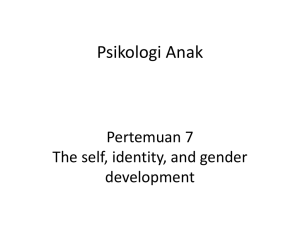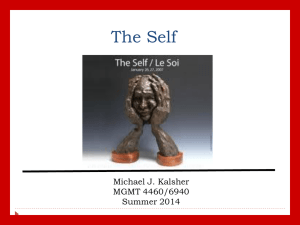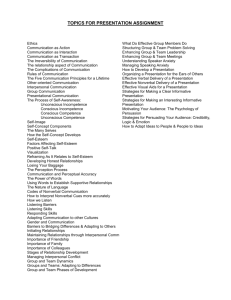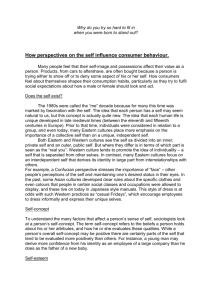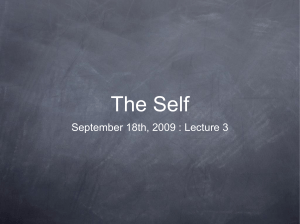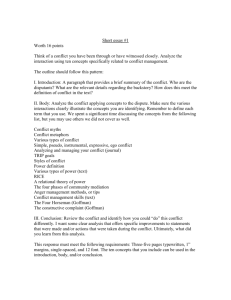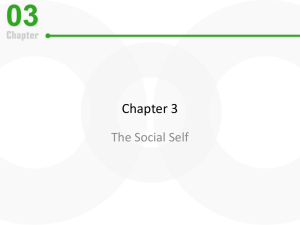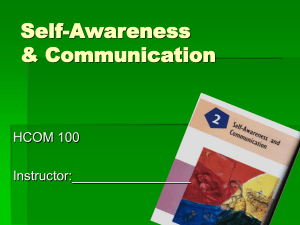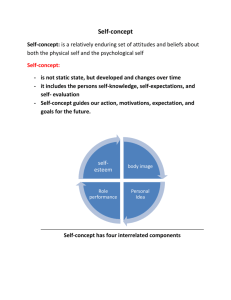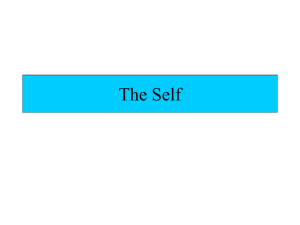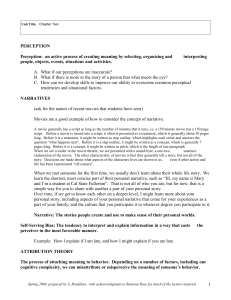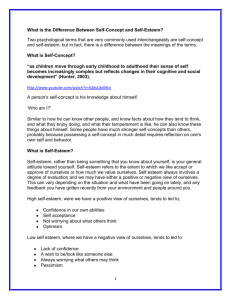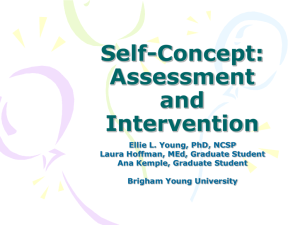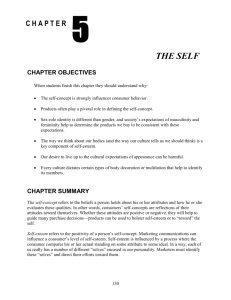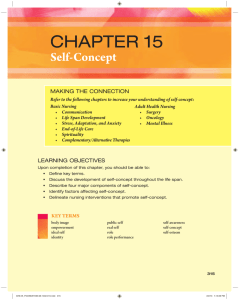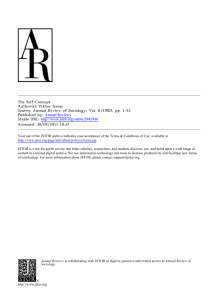Self-Awareness and Communication
advertisement
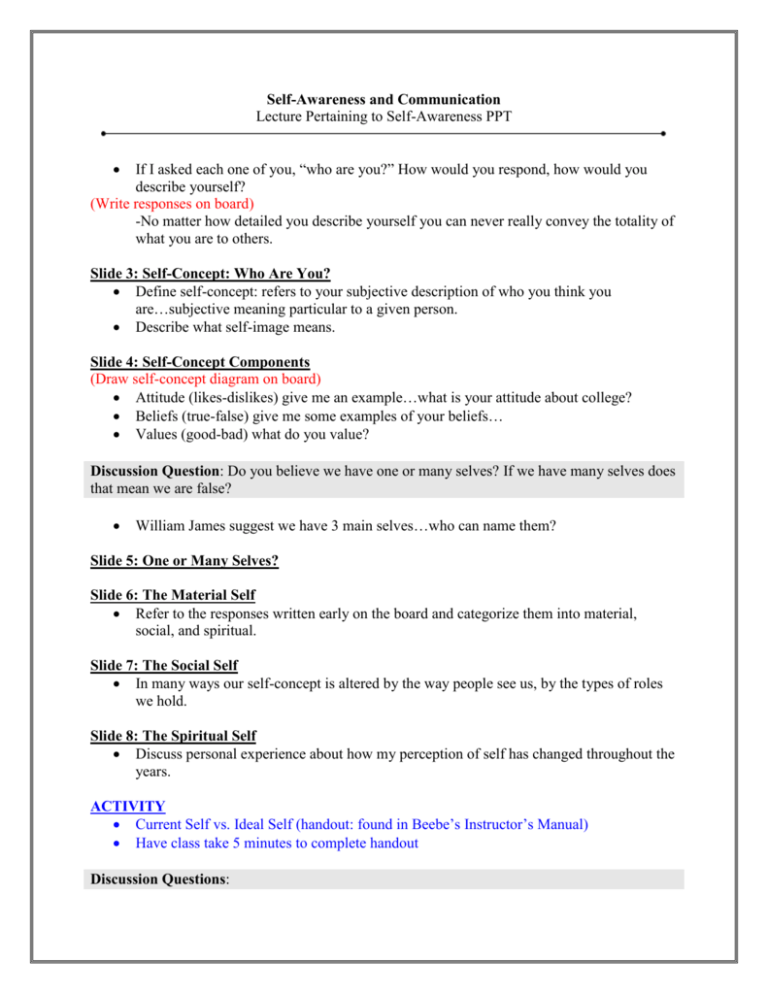
Self-Awareness and Communication Lecture Pertaining to Self-Awareness PPT If I asked each one of you, “who are you?” How would you respond, how would you describe yourself? (Write responses on board) -No matter how detailed you describe yourself you can never really convey the totality of what you are to others. Slide 3: Self-Concept: Who Are You? Define self-concept: refers to your subjective description of who you think you are…subjective meaning particular to a given person. Describe what self-image means. Slide 4: Self-Concept Components (Draw self-concept diagram on board) Attitude (likes-dislikes) give me an example…what is your attitude about college? Beliefs (true-false) give me some examples of your beliefs… Values (good-bad) what do you value? Discussion Question: Do you believe we have one or many selves? If we have many selves does that mean we are false? William James suggest we have 3 main selves…who can name them? Slide 5: One or Many Selves? Slide 6: The Material Self Refer to the responses written early on the board and categorize them into material, social, and spiritual. Slide 7: The Social Self In many ways our self-concept is altered by the way people see us, by the types of roles we hold. Slide 8: The Spiritual Self Discuss personal experience about how my perception of self has changed throughout the years. ACTIVITY Current Self vs. Ideal Self (handout: found in Beebe’s Instructor’s Manual) Have class take 5 minutes to complete handout Discussion Questions: Looking at your ideal selves, why do you want the things you say you do? Where did you get these ideals? As an example, if you want an expensive automobile such as a BMW or Lexus, did you decide this was important or did others around you shape this image? Which self is most important to you right now? Does age have anything to do with the way you identify yourself? Slide 9: How the Self-Concept Develops We learn who we are by the communication with others, receiving their feedback, making sense out of it, and internalizing or rejecting all or part of it, such that we are altered by the experience. -During adolescents friends become influential in shaping our attitudes, beliefs and values. Slide 10: Self-Concept: Communication with Others In 1902 Cooley first advanced the notion that we form our self-concepts by seeing ourselves in a figurative looking glass. We learn who we are by interacting with others, much as we look into a mirror and see our reflection. Slide 11: Self-Concept: Association with Groups What types of groups are you involved in? How have those members helped in shaping your self-concept? Groups may be chosen, such as being Democratic or Republican, or IMPOSED such as ethnicity. Slide 12: Self-Concept: Assumed Roles Self-chosen roles create labels that imply certain expectations for behavior (student/teacher) Biological roles such as gender create certain sex roles. Between the ages of 3 and 5 masculine and feminine roles begin to emerge and they are usually solidified between the ages 5 and 7 years old. ACTIVITY HOW DOES A VIOLATION OF GENDER ROLES AFFECT OUR SELF-CONCEPT? Have students write down a list of things that define women’s role and a second list that defines men’s role in our culture Open a discussion to see what stereotypes emerge, and how roles may be changing. Slide 13: Self-Concept: Self-Labels We talk to ourselves about ourselves and use labels to describe who we are. Slide 14: Self-Esteem: What is Your Value? Self-esteem = self-worth Self-esteem refers to your self evaluation of your identity (Write on board) Four factors affecting self-esteem: gender, social comparisons, selfexpectations, self-fulfilling prophecies. Slide 16: Self Esteem: Gender Differences Patriarchal meaning social system in which the father is head of the household. Text: Athletics help boys cope with changes in their bodies better than girls. Boys – empowered Girls – incapable “man will take care of you” mentality Men: high self-esteem in men is associated with how well they fulfill qualities ascribed to their gender, such as independence and competitiveness. Women: for many women, high self-esteem is related to a sense of being attuned to and connected with others. In a culture that values independence more than connectedness, and competitiveness more than collaboration, it is understandable why women often suffer lower self-esteem when compared to men. VIDEO: TRANSGENDER CHILDREN (Oprah) Discussion: transgender children and their self-esteem, where do they fit in our society? Are we accepting of people who stray from our beliefs or society’s norms? What roles apply to them? Slide 17: Self-Esteem: Social Comparisons Social comparisons should be realistic. Comparing our finances to Bill Gates will create disappointment Slide 19: Self-Esteem: Self-Fulfilling Prophecy People with high self-esteem tend to anticipate or prophesy success People with low self-esteem tend to interpret their success as flukes VIDEO: MY FAIR LADY “You see, really and truly, apart from the things anyone can pick up (the dressing and the proper way of speaking and so on), the difference between a lady and a flower girl is not how she behaves, but how she’s treated. I shall always be a flower girl to Professor Higgins, because he always treats me as a flower girl, and always will, but I know I can be a lady to you because you always teat me as a lady, and always will.” Key Principles The concept of the self-fulfilling prophecy can be summarized in these key principles: - We form certain expectations of people or events We communicate those expectations with various cues People tend to respond to these cues by adjusting their behavior to match them The result is that the original expectation becomes true This creates a circle of self-fulfilling prophecies. Slide 20: Communication and Self: Engage in Positive Self-Talk Self talk refers to “inner speech” Positive self talk can be used in all forms of communication (interpersonal, small group, public) HOMEWORK: Create your own billboard. Bring something into class that symbolizes a part of your self-concept. It can be a poem, song, collage, anything that describes who you are. You will have one minute to share with the class the significance of the item(s) you brought. Slide 21: The Perception Process Refer to outline Slide 22: Communication and the Enhancement of Perceptual Accuracy ACTIVITY: Perception Checking -Put students into dyads. -Each dyad of students comes up with their own conflict scenario and then practices the three steps of the perception check according to the particular conflict. -Each dyad presents their scenario in front of the class (helps prepare them for their 5 minute speech) Three parts to a complete perception check: 1) Describe the behavior you noticed 2) Name at least two possible interpretations of behavior 3) Request for clarification about how to interpret behavior

